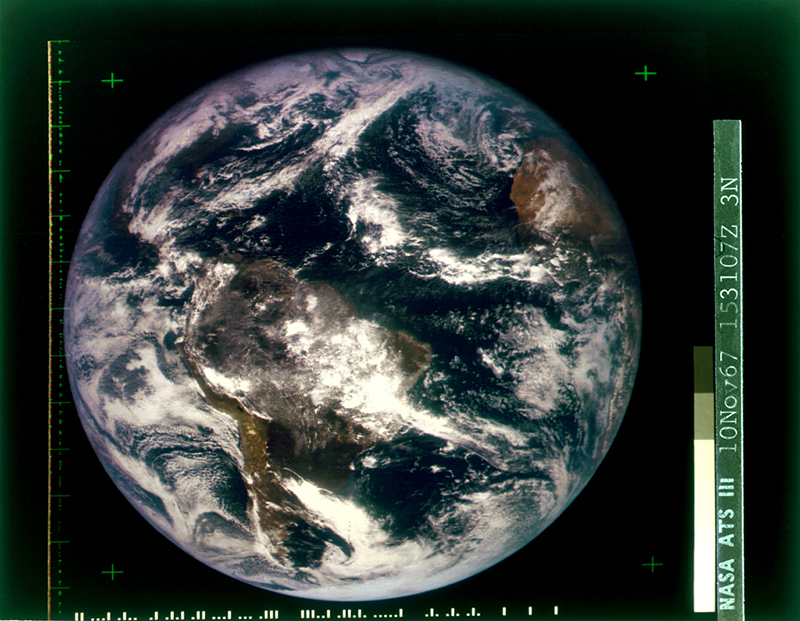November 10, 1967: NASA's First Color Picture of the Earth
- By AMS Staff
- Jun 26, 2023
Photography has been an important tool in the atmospheric sciences since it was invented, and as photography advanced, so too did the quality of weather observations. The very first color photograph of the earth from a satellite came from the U.S. Air Force's DODGE satellite that was launched in 1967.
.png)
But it was NASA's first color photograph of the earth that caused the most excitement for meteorologists with better detail and more consistent readings. NASA's first color image of the whole disc of the Earth from outer space was taken by the ATS-3 satellite from an approximate altitude of 36,000 km when located over the Amazonas mouth on 10 November 1967. This picture was not only a new technological triumph but also revealed a large amount of meteorological information and pushed meteorological research and operations forward.
The colored image provided a striking advantage over black-and-white photographs with the improved contrast of clouds against the Earth background and the resulting higher effective resolution. Particularly over bright land areas with a high surface albedo, color photography obviously permits a better and even more detailed detection of cloud distribution and structure. These days, we are used to all types of color photographs of the earth from a wide variety of satellites, spacecraft, International Space Station, etc. But the excitement of viewing the weather patterns in this first color photograph is evident in the weather analysis that Dr. Guenter Warnecke provided to accompany the picture in 1967.

The First Color Picture of the Earth Taken from the ATS-3 Satellite
The image covered the Earth from the mid-Pacific Ocean to Central Africa and from Antarctica to Central Greenland. Most prominent features are the entire South American continent and western North Africa. The coasts of Morocco and Mauritania clearly stand out in a cloud-free area. The Guinea Coast and the western coasts of Central and South Africa are delineated by the distinct band of intense convection of the sea-breeze front. The same is true, although less pronounced because of the earlier local time, for the coasts of Brazil, Guiana and Eastern Venezuela.
Large portions of the Andes are seen under clear sky conditions. Well recognizable are Lake Titicaca, Peru (dark) and the Bolivian Salars de Coipasa and de Uyuni (bright beige) while the Atacama Desert, Chile, appears only slightly brighter than the surrounding land areas. Extended patches of fog are recognizable over the Gulf of Guayaquil (Ecuador) and along the coast around Lima, Peru.
Of particular meteorological interest are a number of pronounced frontal cloud bands, as well as certain mesoscale structures between them, which permit one to infer some circulation characteristics. A pampero cold front is crossing southern South America with its main cloud mass over the La Plata region and a very sharp squall-line over Uruguay and northern Argentina. Over the Andes and just to the east of it, the frontal cloud system is dissipated but can again be traced over the Pacific Ocean although it is less distinct under more anticyclonic influence. However, in this region the cloud pattern itself makes it easy to distinguish between the pre- and post-frontal cloudiness because of the pronounced cellular and banded convection within the newer polar air mass. South of the front, heavy cloudiness is caused over Chile on the windward side of the Andes. A secondary cold front appears to follow farther south, where it just arrived at the southern tip of the continent. Toward the north a preceding front can be found over eastern Bolivia and southern Brazil. The divergent flow of the moderated polar air mass can be traced by a beautiful pattern of cloud streets over the lowlands of the Paraguay River and the southern Provinces of Brazil. The highly organized post-frontal cloud pattern can easily be distinguished from the completely un-organized convective cloudiness north of this front. Toward the west, traces of the frontal cloud structures can be found far out over the Southern Pacific Ocean. A significant break over the Andes and over the Peru or Humboldt Current should be taken into account. The cloud-suppressing effect of the cold water current off the Peruvian coast is very apparent in this picture as is also shown over the Benguela Current off Southwest Africa. Large, highly un-organized convective cloudiness spreads all over tropical South America north of 15S. The cloudiness over the Amazonas is, however, less intense than over the Brazilian Highland area, which is experiencing the rainy season at this time of the year. The inter-tropical convergence zone is well shown by an extended band of strong cloudiness over Panama and northern Colombia, which is presumably of more orographic origin. An interesting detail is the strong cirrus outflow toward the northeast from the heavily convective cloud systems over Central America, east of an upper trough (see Fig. 5). The equatorial dry zone evident over the Pacific also extends across the Atlantic toward Africa.
Of extreme meteorological interest is the cloud structure over the southern North Atlantic. The intertropical convergence zone over Africa is defined in this picture by a cluster of individual convective storms with distinct indication of cirrus cumulonimbogenitus clouds blowing from the storm clouds toward the east, south of the Niger River. Over the ocean, the ITC exhibits a very remarkable structure of apparently three distinct but narrow lines of stronger cloud activity from the African coast to approximately 30W. From there on, only one very narrow, partly interrupted and meandering line of cloudiness survives along 10N and the broad band of main cloudiness turns toward the northwest, finally merging with an extra-tropical frontal system which extends from Honduras across the North Atlantic Ocean toward Iceland. Near 50W, a vortex-like structure of the heaviest cloud mass with an anticyclonically spiraling cirrus outflow on its northern rim is an indicator for a small surface cyclone. This storm developed out of the ITC during the previous days when the decaying tropical storm "Heidi" curved back into this region after a brief excursion to the Azores.
The cold front over Morocco is dissipating in the cloud picture over the ocean and can only be traced as a weak line of clouds for about 1000 km. On both sides of the ITC, the direction of the trade winds can be derived from the clearly visible cloud streets. Off the Morocco coast a cyclonic vortex center is recognizable within the cellular convective cloud pattern of a cut-off low which is characterized by a number of cumulonimbus and shower reports in the surface observations. Another vortex center is shown southeast of Greenland connected with the frontal cloud band already mentioned extending from Cuba toward the northeast. Greenland itself is shown clearly by its bright ice-cap surrounded by open water under clear skies and within anticyclonic weather conditions. The small cloud-free strip along its coast is produced by the predominance of katabatic outflow and the superimposed anticyclonic subsidence. North America is shown partly under clear skies. The east coast up to New York and the Gulf Coast east of the Mississippi delta can be well seen. Eastern Canada is covered by the cloudiness of a frontal system that extends from Baffin Island southwestward to the Great Lakes. The Midwest is covered by heavy rain clouds in connection with an upper trough extending as far south as Mexico.
The feasibility of meteorologically useful color photography from synchronous satellite altitudes has been successfully demonstrated. The wealth of meteorological detail information of even the single picture shown has not been exhausted with this brief interpretation. The main advantage of cloud photographs from synchronous altitudes is, however, the possibility of producing time series in 20 to 30 minute steps, at the present state-of-the-art, which has been demonstrated by a number of movies produced from the ATS-1 photos by V. E. Suomi and T. Fujita. The superiority of color photography is based on the ability to detect the color peak of the reflectance curve of the different natural objects like water, land, and clouds in addition to the integrated intensity, which is the only parameter detectable by black-and-white photography.
The simultaneous operation of two meteorological satellites in synchronous orbits is a large further step toward a complete meteorological observation system of three equally spaced synchronous satellites in addition to one or two near-Earth satellites in quasi-polar orbits, as proposed for the World Weather Watch. This permits research workers to observe and investigate short-term variation of daytime cloudiness over more than two thirds of the globe, primarily over the vast tropical and subtropical oceanic areas.
In addition to this exciting weather information, the ATS-3 also provided regular communications service to sites in the Pacific basin and Antarctica, supplied emergency communications links during the 1987 Mexican earthquake and the Mt. St. Helens disaster, and supported the Apollo moon landings with real-time TV transmissions for broadcasting by Radio Caracas in Venezuela.
This article was edited and abridged from an original article by G. Warnecke and W. Sunderlin for the AMS Weather Band. All errors and omissions may be attributed to AMS Staff. Copyright remains with the AMS.
